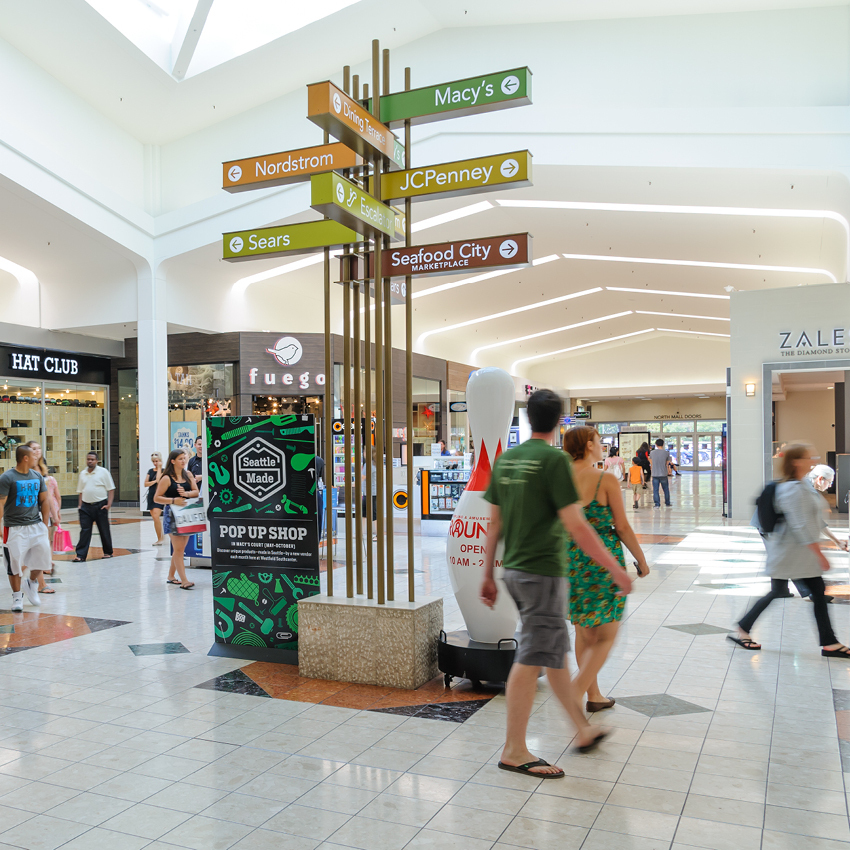Of the roughly 1,000 malls in the U.S., more than a third are rated C or D, which are grades that indicate low sales productivity, high vacancy rates, poor tenant quality, and other weaknesses. Once the retail apocalypse gained steam around 2015, it quickly became clear that most of these properties wouldn’t be viable as malls by 2030.
The Covid-19 pandemic dealt malls another blow last year. Public health orders forced most U.S. malls to close for months and ratcheted up the financial pressure on many of their tenants. Moreover, during 2020 many Americans reported that they wouldn\’t feel safe going to a mall. This led many industry experts to become far more pessimistic on the sector\’s prospects and predict that a large proportion of U.S. malls would close within a few years.
Instead, mall traffic and sales have come roaring back in 2021, confounding pessimists\’ expectations. This in turn has driven a surge in leasing activity. That means the long-expected mall shakeout won\’t be as quick or as dramatic as many in the industry seem to expect.
Predictions of Doom
Malls face major threats from two directions. First, the declining fortunes of U.S. department stores has led to a raft of anchor vacancies. Even those department stores that remain generate less traffic than they did a decade or two ago. Second, the rapid growth of ecommerce and the continued expansion of off-price, discount, and dollar stores have drawn shoppers away from malls.
The pandemic aggravated these trends. Department stores and most other mall-based retailers were classified as nonessential businesses and forced to close temporarily during the spring of 2020. Off-price stores had to close, too, but ecommerce companies weren\’t affected, and most discount and dollar stores were able to continue operating as essential businesses.
This caused many experts to predict imminent doom for department stores and the malls where they are located. In April 2020, Green Street Advisors predicted that more than half of all mall-based department stores would close within less than two years, triggering co-tenancy clauses and putting many malls at risk of imminent closure.
Retail expert Jan Rogers Kniffen took an even more dire view of things. As of June 2020, he expected 50,000 stores to close during 2020: up from 10,000 in a typical year. As a result, he projected that a third of U.S. malls would close by the end of 2021, compared to his prior belief that those closures would stretch out to around 2030. His view became gloomier as the year progressed. By December, Kniffen was arguing that only the best 278 U.S. malls (roughly corresponding to A malls) would be viable in the long term.
Veteran retail executive Mark Cohen sees things similarly, with the fading relevancy of department stores eventually taking down virtually the entire U.S. mall sector, outside of a few hundred A malls.
Store Closure Spike?
So far, these pessimistic predictions haven\’t been borne out. Surprisingly few mall-based department stores have closed. Belk, JCPenney, Neiman Marcus, and Lord & Taylor all filed for bankruptcy in the year after the pandemic hit, but only Lord & Taylor liquidated. Stein Mart and Stage Stores also went out of business, but neither company focused on full-sized mall-based department stores.
Belk didn\’t shutter any stores in conjunction with its bankruptcy. Neiman Marcus closed a handful. And while JCPenney trimmed its fleet by about 20 percent, its store closures were heavily skewed towards undersized small-market locations rather than mall-based stores. And given that Lord & Taylor had fewer than 40 stores in its fleet as of last summer, its disappearance had little impact at a macro level.
Other department store operators haven\’t significantly changed their store plans. Larger national chains like Macy\’s continue to trim their store counts, but that\’s just a continuation of what they were doing before the pandemic. And regional chains like Dillard\’s, Boscov\’s, and Von Maur are holding their store counts roughly flat (or even growing slightly).
All told, perhaps 10 percent of mall-based department stores will ultimately close during the two years following the pandemic: a far cry from the dire predictions of many analysts and retail experts.
A similar story has played out across the retail industry more broadly. Coresight Research tracked just 8,741 store closures last year, a decrease from previous years (and far below its June prediction that as many as 25,000 stores would close in 2020). In January, Coresight founder and CEO Deborah Weinswig anticipated that store closure activity would accelerate in 2021, but the pace of store closures slowed further in the first half of the year.
Malls Return to Good Health
If you\’re thinking that the slowdown in store closures is just the calm before the storm, think again. It\’s true that mall owners offered rent deferrals or abatements last year to help struggling tenants. But those sacrifices are paying off handsomely, as a strong rebound in mall traffic over the past six months has returned most mall tenants to health.
Top U.S. mall owner Simon Property Group told investors in early August that tenant sales rebounded to 2019 levels in June. Simon\’s sales results would have been even better but for the fact that it owns a number of trophy assets (such as Sawgrass Mills, Woodbury Common, the Forum Shops, and King of Prussia) that typically get a lot of tourist business and are still hurting relative to 2019.
Mall owners less reliant on tourism are reporting even stronger sales numbers. Macerich said that comparable sales for small-shop tenants at its malls jumped 13.4 percent over 2019 levels last quarter, including a 14.9 percent increase in June. PREIT announced a 16 percent comparable tenant sales increase compared to 2019 for the month of June, followed by a 17 percent increase in July (despite growing concerns about the Covid-19 Delta variant).
With shoppers returning to malls and opening their wallets like never before, leasing demand has come roaring back. In fact, many mall owners reported leasing volumes well ahead of 2019 levels in the first half of 2021, with lots of additional deals in the pipeline for the second half. This is helping to backfill vacancies created over the past few years.
Department stores are getting a new lease on life, too. Macy\’s and Dillard\’s reported record second-quarter profits, as sales surpassed 2019 levels and margins expanded dramatically due to cost cuts and less discounting. (During the same period two years ago, Dillard\’s lost money and Macy\’s eked out a small profit.) These results may not be sustainable, but even a short-term surge in profits will enable department stores to clean up their balance sheets and invest in their businesses to drive longer-lasting improvements.
Importantly, the rebound in mall traffic and sales extends well beyond A malls. As noted above, PREIT has seen mid-teens sales growth relative to 2019 in recent months despite primarily owning B malls. Its regionally dominant B malls serving markets like Harrisburg, Pennsylvania; New Bedford, Massachusetts; Jacksonville, North Carolina; Florence, South Carolina; and Hagerstown, Maryland have generally recovered more robustly than its malls in the Philadelphia and Washington, D.C. suburbs.
Why Do Malls Close, Anyway?
None of this means that the 2020s will be just like the 1990s for malls. While many malls are bouncing back surprisingly strongly, the weakest properties remain stuck in a long-term downtrend. Many metro areas have too many malls, and it\’s incredibly difficult for the losers to turn things around. (Over the past decade, there has been a strong trend towards fewer trips and higher spending per trip, which makes consumers increasingly likely to bypass a weaker mall near their home in favor of a top-tier property further away.)
However, just because a mall is struggling doesn\’t mean it will close. Consider, for example:
- South Mall in Allentown, Pennsylvania. As of early 2014, when former owner PREIT sold the property for $23.6 million, it was already struggling mightily, with dismal sales per square-foot of just $227. Since then, both of its anchor tenants (Bon-Ton and Stein Mart) have gone out of business.
- The Lehigh Valley region (with a population of about 860,000) is home to two better malls and an upscale lifestyle center, giving South Mall no reason to exist. And yet the mall soldiers on. Half a dozen new local tenants have opened in recent months, likely taking advantage of extremely low rents.
Indeed, if there\’s no clear alternative use for a struggling mall, the owners will likely continue operating it until cash flow turns negative. Dwindling occupancy and falling rents will eventually erode cash flow to this point (particularly if major maintenance projects become urgent). But this process takes a long time to play out. By slashing expenses to the bone and reducing rents to fill vacancies, it\’s often possible to continue squeezing cash flow out of past-their-prime malls with multiple anchor vacancies for many years.
Malls are far more likely to close if they sit on valuable land. For example, Macerich has closed two of its malls in recent years, both in big cities. It contributed the former Westside Pavilion in Los Angeles to a joint venture at a $190 million value for redevelopment, primarily as office space for Google. More recently, Macerich closed Paradise Valley Mall in Phoenix and contributed it to a JV at a $100 million valuation for a major mixed-use redevelopment.
Other malls that have recently closed or are expected to close soon are disproportionately located in pricey coastal markets. These include the White Plains Galleria (New York metro area); Lakeforest Mall and Landmark Mall (Washington, D.C. suburbs); Northgate Mall (Seattle), Shops at Hilltop (San Francisco metro area), Westminster Mall (LA suburbs), and Horton Plaza (San Diego).
To be fair, some malls in the exurbs and midsized cities have recently become targets for Amazon and other companies looking to build distribution and fulfillment centers. But most malls would not be particularly valuable as sites for these uses, either
Even mall pessimists acknowledge that most A malls will continue to thrive for the foreseeable future. The recent revival in mall sales and leasing will keep most of today\’s B malls operating for at least another decade, too, even if most remain less profitable than they once were. That means the U.S. will still have at least 600 malls open a decade from now.
By contrast, most of the C and D malls that were struggling before the pandemic will disappear by 2030. Still, due to the lack of valuable alternative uses for many malls, the closures will be drawn out rather than clustered in the next few years. To paraphrase the famous words of legendary economist Adam Smith, there is a great deal of ruin in a mall.
Full disclosure: The author owns shares of Macy\’s, Macerich, and PREIT.




